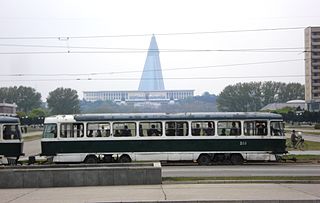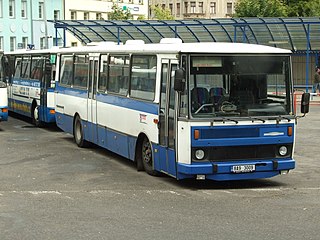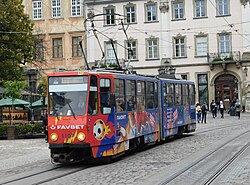
A low-floor tram is a tram that has no stairsteps between one or more entrances and part or all of the passenger cabin. The low-floor design improves the accessibility of the tram for the public, and also may provide larger windows and more airspace.

ČKD was one of the largest engineering companies in the former Czechoslovakia and today's Czech Republic. It is famous for the Tatra T3, a tramcar that sold 13,991 units worldwide.

The LM-49 is the Soviet motor four-axle tramcar. The first prototype of this vehicle was built in 1949 at the Leningrad Wagon Repair Plant. "LM" means Leningrad Motor tramcar. These tramcars were utilized in Leningrad itself and some other Soviet cities such as Minsk, Gorky, Novokuznetsk and Magnitogorsk. VARZ produced in total 287 LM-49s for Leningrad and 113 for other cities.

MTV-82 is a Soviet four-axle tramcar.

Germany has an extensive number of tramway networks. Some of these networks have been upgraded to light rail standards, called Stadtbahn in German. Straßenbahn and Stadtbahn schemes are usually operated on the legal foundation of the BOStrab, the Tramways Act of Germany.

The Tramway Français Standard (TFS) is a type of tram designed and manufactured by Alstom for use on various tramway systems in France. The TFS is no longer in production, having been superseded by the Alstom Citadis range of tramcars.

The Tatra KTNF6 is a modernized tram, type KT4, rebuilt with a central low-floor segment. These types of tram cars are used in Cottbus, in Brandenburg City and Schöneiche-Rüdersdorf, Germany, and in Tallinn, Estonia. Another similar variant of KT4 is KTNF8, which is used in Gera (Germany).

Pyongyang Tram is a public tram system in Pyongyang, the capital of the North Korea. The first line of the current system opened in 1989. There are currently four lines in operation.

Trams and trolleybuses in North Korea are forms of public transportation for North Koreans to travel around in urban centres given the shortages on fuel and access to cars for average citizens.

The Vinnytsia Tramway network is the part of the public transportation system that since 1913 serves Vinnytsia, the administrative center of the Vinnytsia Oblast, Ukraine. The tram system has a narrow rail gauge of 1,000 mm that only exists in Ukraine in the cities of Lviv, Zhytomyr and Yevpatoria, as well as Vinnytsia. The system currently consists of 21.2 km of tracks.

The Potsdam tramway network is a network of tramways forming part of the public transport system in Potsdam, the capital city of the federal state of Brandenburg, Germany.

Tatra KT8D5 is a bidirectional light rail vehicle currently operating in Europe and Asia. In several variations, it was designed and manufactured by Czech engineering corporation ČKD Tatra from 1984 to 1999 and a total of 206 cars were sold. The vehicle has an angular design similar to Tatra T6A5, Tatra RT8D5M, and Tatra KT4 both outside and inside. During its production period, several versions of KT8D5 were sold.

The Pyongyang trolleybus system forms part of the public transport network of Pyongyang, the capital city of North Korea, and extends to some of its suburbs.
The automotive industry in North Korea is a branch of the national economy, with much lower production than the automotive industry in South Korea. In North Korea motor vehicle production is focused on military and industrial goals, including construction; few private citizens own cars.

Tatra T6B5 is a Czechoslovak-built high floor four axle tram with a pulse-width-modulation ('chopper') speed control. This model of tram was produced by CKD Praha in Smíchov, Prague in the period of 1983–1995, following one year in Zličín until 1996. After ČKD Praha went bankrupt, the final assembly and sale of incomplete trams were managed by Inekon Trams until 2007. The last four trams were supplied to the city of Ufa by late 2007. About 1,150 tramcars of this model were produced. In the former Soviet Union, it is also known as Т-3М. In 2015 most of these trams were used in Russia, Belarus, Ukraine, and Uzbekistan.

The production of urban electric transport is a branch of Russian engineering. Russia has the largest number of trolley (85) and tram systems (86) in the world.

Karosa C 734 is an intercity bus produced from 1981 to 1996 by bus manufacturer Karosa from the Czech Republic. It was succeeded by Karosa C 934 in 1996.

The Tallinn tram network is the only tram network in Estonia. Together with the four-route trolleybus network (et), the four tram lines, with a total length of 19.7 km arranged in a roughly cross-shaped layout, provide a backbone for the public transport network in the Estonian capital. All the routes meet up at Hobujaama in the city centre. Trams are unidirectional, one-sided and single-person operated, and much of the network runs on segregated track.

LT-10 is a series of Ukrainian high-floor four-axle tram cars, produced from 1994 to 1998 on the Lugansk Locomotive Plant.

The KTM-5, later known as the 71-605, is a Soviet tram model manufactured by UKVZ. First introduced in 1963, the KTM-5 was mass-produced between 1969 and 1992, with a total of 14,991 tramcars being made. KTM-5 trams were built exclusively for the Soviet Union, and therefore are currently only operating in post-Soviet states.
































































